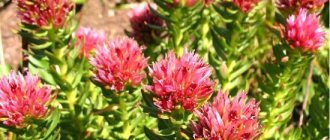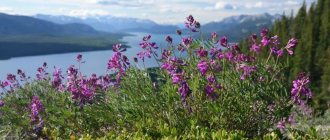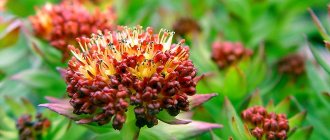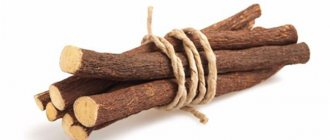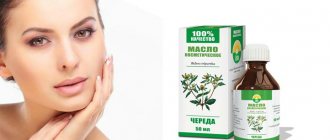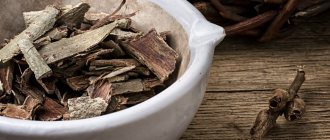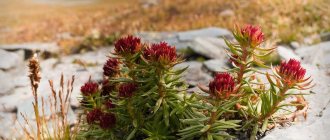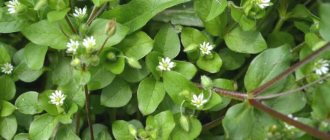The herbaceous perennial from the Madder family has several popular names - marina, marzana, crapp (krapp), petiolate madder or Georgian madder. Its Latin name (Rubia tinctorum) comes from the words rubber, which translates as “red”, and tinctorus – “dyeing”.
Madder root is considered a natural dye, which was used in the textile industry until the end of the 19th century. Today this plant is valued for its healing properties. You will learn about the medicinal properties and contraindications of the red root from this material.
What does madder look like?
Externally, the plant resembles St. John's wort: small flowers, elongated dense leaves curled into a ring around the stem, sharp small thorns. The stem of madder is thin, covered with rough bark. It can reach a height of one and a half meters.
The leaves are wide and dense, covered along the edges with sharp bristles. Madder blooms with small greenish-yellow flowers that resemble St. John's wort inflorescences. The powerful root system consists of the main root and numerous thin roots covered with brown bark.
Description, reproduction and distribution area of madder
Perennial herbaceous plant of the madder family (Rubiceae), up to 2 m high.
The main root is powerful. Roots with thick creeping rhizomes extend from it. The roots and rhizomes are covered with reddish-brown exfoliating bark. The stem is thin, climbing, highly branched, tetrahedral, spiny and rough.
The leaves are light green, obovate, dense, woolly-spinous below, opposite, collected in whorls of 4-6 pieces, up to 9 cm long and up to 3 cm wide.
The flowers are small, yellowish-green, up to 1.5 cm in diameter, collected in few-flowered semi-umbrellas at the ends of the stems and branches.
The fruit is a juicy black drupe up to 5 mm long; their juice leaves almost indelible dark wine-red stains.
It blooms in June - September, the fruits ripen in August - November in the first year of life. Propagated by seeds and vegetatively.
Madder is widespread in the wild in Dagestan, Azerbaijan and other regions of the Caucasus, Crimea, and Central Asia. Grows in riverine tree and shrub thickets, on pebbles, steppe meadows, forest edges, in light pine forests, gardens, vineyards and along fences.
Madder is undemanding to the mechanical composition of soils: it grows on sand, loams and continuous soils of solonetzes.
Even in ancient times, artisans of the ancient Greeks, Romans, Egyptians and Persians highly valued madder root. Permanent red paint was obtained from it. In ancient times, madder was perhaps the only plant that was used to dye wool, silk and cotton fabrics. Madder root was well known in modern times. Textile workers were especially interested in it. The Free Economic Society of Russia established a high award - a gold medal and a cash prize for the development of resistant varieties of madder.
The medicinal properties of the plant have also been known since ancient times. Avicenna recommended preparing a drink from its roots in water sweetened with honey for the treatment of the sciatic nerve, paralysis, and loss of tissue sensitivity. The fruit was also used to make a drink with uxomed for an enlarged spleen. “It cleanses the liver and spleen and opens blockages in them,” wrote Avicenna.
Madder root
This herb was first used in the textile industry. Dyes from madder root made it possible to dye various natural fabrics - silk, cotton, wool. Now the plant is used in folk and traditional medicine.
Traditional healers use this medicinal herb to prepare tinctures, decoctions and powders that provide relief from many serious diseases. In traditional medicine, the complex drug “Cystenal” has become widespread. The drops contain: extract from madder rhizome, magnesium salicylate, ethyl alcohol, eucalyptus, anise, phenicyl essential oils, olive and castor oil.
This medicine is prescribed for spasms and inflammation of the urinary canals, and urolithiasis. Take Cystenal five drops half an hour before meals. After conducting the necessary examinations and consulting with a doctor, a specialist may increase the dosage or extend the course of treatment. Taking drops during meals reduces acidity. Treatment lasts a month.
Side effects
Exceeding the dose can cause painful spasms in the stomach, provoke complications of chronic urological diseases, and disrupt the acid-base balance. In rare cases, an allergic reaction and nausea may occur.
During treatment with madder decoctions, urine usually turns pinkish-red. If the color of the urine becomes more saturated, you should reduce the dosage or concentration of the drug, or temporarily stop taking it.
The presence of large amounts of acids, salts and iron in madder has a detrimental effect on tooth enamel, thinning it.
Herbal tea, decoctions and infusions of this medicinal plant must be drunk with a straw or from bell cups with a spout to minimize contact of the liquid with the teeth. After taking it, you need to brush your teeth or rinse your mouth with water.
Chemical composition
The medicinal properties of madder roots are due to their rich chemical composition. They contain:
- tartaric, citric, malic organic acids;
- flavonoids;
- coumarins;
- ascorbic acid;
- anthraquinones;
- pectins;
- sugar;
- iridoids;
- B vitamins;
- essential oils containing phenols;
- proteins;
- tannins;
- carbohydrates;
- iron;
- potassium;
- natural dye;
- magnesium.
Pharmacological composition
The beneficial properties of a medicinal plant are determined by its composition. The key biologically active substances of the madder family are:
- Triterpenoids (oxygen-containing organic compounds) inhibit inflammatory processes and destroy pathogenic microbes.
- Iridoids (bitter glycosides) - promote the removal of bile and harmful toxins, block muscle spasms and reduce inflammation.
- glycosides are indispensable in the treatment of arrhythmia and strengthening of the heart muscles.
- Anthraquinones and derivatives purpurin, ibericin, rubiadin, alizarin are responsible for immunity and cell anabolism.
- Coumarins have an antitumor effect.
- Flavonoids - have an antimicrobial effect, reduce vascular fragility, normalize heart rate and blood pressure, destroy cholesterol plaques, and remove toxins.
- Vitamin C is responsible for the immune system and regenerative functions.
- Pectins – stabilize metabolism.
- Organic acids (malic, tartaric, citric) improve peristalsis, normalize metabolism, and have a laxative and diuretic effect.
- Macro and microelements (boron, potassium, magnesium, iron, zinc).
- Proteins and carbohydrates are an irreplaceable part of food, they help to acquire new cells to replace worn-out ones, and are actively involved in metabolism.
- Tannins , which make leather strong but elastic.
It is this rich set of useful substances that makes the use of madder so effective.
Medicinal properties
Madder herb has powerful nephrolytic properties. The substances contained in this plant have a destructive effect on kidney stones and promote their elimination. Medicines made from the root of the plant relieve pain and spasms, normalize water-salt balance, and loosen phosphates and oxalates.
Traditional healers successfully cleanse the body of waste and toxins with herbs. Once in the stomach, madder preparations stimulate the production of gastric juice, have an anti-inflammatory effect, enhance the excretion of bile, and cleanse the body of toxins and waste.
In addition, this medicinal plant cleanses the blood, improves immunity and promotes cell renewal. Coumarins contained in the herb destroy malignant cells, preventing the appearance of tumors. Juice obtained from madder root is effective for rickets and abdominal pain. Decoctions and tinctures of madder remove excess salt from the body, helping in the fight against osteochondrosis and joint diseases. By supplementing the root with other ingredients, you can heal wounds and bruises and clear the skin of rashes.
Contraindications for use
Despite a number of valuable properties of the medicinal plant, there are diseases for which its use is strictly prohibited:
- acute heart failure (AHF);
- liver failure;
- renal dysfunction syndrome;
- stomach and duodenal ulcers;
- glomerulonephritis and tubulointerstitial nephritis;
- with caution during pregnancy and lactation;
- individual intolerance.
The use of madder must always be coordinated with specialists in order to avoid side effects and achieve maximum therapeutic results.
Uses of madder
The medicinal properties and contraindications of the red root largely depend on the chosen dosage form. It has already been said that traditional healers prepare decoctions, tinctures, herbal teas and infusions from madder. Pharmacies offer to buy madder extract, which can be in the form of drops, powder or tablets.
In different forms, madder herb has different rules of use. More often in medicine, it is not the above-ground part of the plant that is used, but the root, the use of which differs from the greenery of the plant.
Botanical description
Madder is a plant with a strong main root (called “krapp”) with thick rhizomes extending from it, covered with red-brown layered bark. Thin, highly branched, climbing, tetrahedral stems of the plant, planted along the ribs with prickly, curved needles, begin to grow in mid-May. Dense, hard, light green leaves of lanceolate or elliptical shape, seated along the edges and on the underside of the plate with frequent curved needles and collected in whorls of 2-6 pieces, reaching a length of 10 and a width of 3 cm. They can be sessile or attached to stem with a short, winged petiole. Small star-shaped yellow madder flowers with funnel-shaped corollas are collected in axillary or apical semi-umbrellas. Flowering begins in June and ends in August. Madder fruits, black drupes with juicy pulp up to 9 mm long, ripen from August to November in the first year of growth.
How to take medications
Madder drops are used to remove calcium oxalates. They cause kidney stones. In accordance with the instructions, 20 drops of the drug are diluted in a glass of water. Take the medication before meals twice a day for a month.
Tablets from madder root should be taken 2-3 pieces, having first dissolved them in a glass of warm water. Treatment lasts from 20 days to a month, depending on the doctor’s recommendations.
Judging by people's reviews, after treatment with madder, if a person neglects contraindications, his chronic diseases may worsen. Before starting treatment, you must consult with a specialist and strictly follow the instructions for use of the drugs.
Methods of preparation and use
Traditional medicine prepares strong tinctures and aqueous preparations based on madder dye. In addition, plant extract is available for purchase in pharmacies - a dry concentrate with strong medicinal properties.
Madder tincture
An alcoholic tincture of the perennial is used for anemia, stones in the ureters and kidneys, and for diseases of the spleen. Recipe:
- The dried roots of the plant are ground to a powder.
- Pour the raw material with 100 ml of medical alcohol diluted with water in a 1:1 ratio.
- Store in a closed container in a dark closet for two weeks.
- Strain the product through gauze.
We recommend reading: European hoofweed (common): use for alcoholism, reviews
The tincture should be taken three times a day in a dosage of up to 20 drops.
When using madder tincture, you must drink at least 1.5 liters of clean water per day.
Madder extract
The plant extract is available for purchase in tablets and capsules. Use the drug according to the instructions, usually dilute 2-3 tablets in 150 ml of warm water three times a day.
You can use the extract for kidney stones, nephrolithiasis, urinary tract infections, pain and spasms. The use of the product must be agreed with a doctor, since if used incorrectly, it can harm the body.
It is necessary to drink madder extract for a month, followed by a break of the same duration.
Infusion, decoction of madder
Aqueous preparations are prepared from the dried roots of a medicinal plant at home. In particular, for cystitis, urethritis and other inflammatory diseases of the urinary tract, it is recommended to make a healing infusion:
- Pure water in a volume of 200 ml is heated to approximately 85 °C.
- Pour 20 g of dry madder roots into the liquid.
- Leave covered to infuse for three hours.
- Strain.
Take 75 ml of infusion on a full stomach.
For external use, you can prepare a decoction. The recipe looks like this:
- About 10 g of crushed perennial roots are poured into 100 ml of liquid.
- Heat in a water bath for 15 minutes.
- Cool the medicine and filter.
A clean cloth is moistened in a warm decoction and applied to the joints for rheumatism, polyarthritis and gout. At the same time, the product can be taken orally, half a glass three times a day.
A decoction of madder root, when rubbed, cleanses the skin and slows down its aging
Powder for kidney stones
Madder root for urolithiasis dissolves stones, promotes their painless removal, and reduces the accumulation of harmful phosphates and salts in the ducts. To prepare the medicine, you need to dilute 1 gram of plant root powder in 100 ml of water. Take the resulting product three times a day before meals.
When treating urolithiasis, you should undergo a full medical examination. Products that contain citric and oxalic acid are excluded from the patient's diet. Vitamin complexes must be prescribed.
pharmachologic effect
Rubia tinctorum is a remedy of plant origin. It has a diuretic and antispasmodic effect on the body. Under the influence of the drug, there is a decrease in the tone of smooth muscles, as well as an increase in its peristalsis. As a result, sand from the kidneys, as well as small stones, especially those containing calcium and magnesium phosphates, are painlessly expelled from the body.
Under the influence of the drug, urine is acidified, the severity of pain is reduced and the general condition of the body improves in people suffering from nephrourolithiasis. During therapy, the drugs gradually loosen and color the kidney stones red.
Treatment of cystitis
Due to the anti-inflammatory and bactericidal properties of madder root, the infusion is used for cystitis. To prepare it, fresh root of a small plant is poured with a glass of cold purified water, then infused for eight hours. The infused mixture is filtered, and the crushed root is poured again with 200 ml of boiling water. Strain the second part of the infusion after a quarter of an hour. Then mix both parts.
Divide the infusion into two servings and drink them throughout the day. This composition relieves inflammation, discomfort and pain.
Madder collection and storage
For medicinal purposes, madder roots and rhizomes are harvested in the second or third year of the growing season, respectively: at the end of summer, from early August to late September, or in spring, from mid-March to mid-April. The roots are dug up, cleared of soil and, without washing, laid out in an open place under the sun to wilt. Then they are dry-cleaned from soil residues and dried in the shade or in a dark, dry room with good ventilation. If you decide to use an oven to dry the raw materials, the temperature in it should not exceed 45 ºC. Dry raw materials are placed in glass jars and sealed tightly. Madder roots can be stored for two years.
Decoction for gout
How to brew madder root to remove salt deposits during padagre, normalize metabolism and improve the condition of joints? It is necessary to pour boiling water (300 ml) into one spoon of root powder and place the container on low heat. Bring the mixture to a boil and simmer for 10 minutes. Cool at room temperature and strain the broth.
Take 100 ml of decoction three times a day 40 minutes after meals. After just 10 days of taking the drug, the patient feels a decrease in joint pain and an increase in motor activity.
Growing madder
Landing
Madder is a heat-loving, moisture-loving plant that is demanding on the composition and fertility of the soil: its roots penetrate up to 35 cm deep, so the soil must be loose and structured, otherwise you can’t count on a good harvest. The best soil for madder is light or medium loamy, enriched with humus and well fertilized. It is advisable to sow madder after winter grains, early forage or vegetable industrial crops in an area that was previously fallow.
Before sowing, fall plowing is carried out on the site or the soil is dug up to the depth of a spade, filling each m² of land with 2 kg of humus or compost, then the site is harrowed and cultivated to a depth of 6-7 cm. The seed is treated before sowing with Granosan at the rate of 2 g of the drug per 1 kg of seeds.
- Mint: growing from seeds at home and in the garden
In areas with a warm climate, madder seeds are sown directly into the ground in the second half of April, when the soil warms up to 6-8 ºC. Sowing is done to a depth of 4-5 cm, maintaining a row spacing of 45-60 cm. At a temperature of 10 ºC, seedlings can appear within two to three weeks, however, under unfavorable weather conditions, the process of seed germination can take 30-40 days. The most favorable temperature for the growth and development of madder is 23-25 ºC.
Madder is also grown from rhizomatous cuttings 6-8 cm long, which are planted at a distance of 10-15 cm from each other in furrows 8-10 cm deep cut with a cultivator. The filled furrows are rolled and watered.
Rules of care
Madder may bear fruit in the first year, but there will be few of them. Normal fruiting will begin at 2-3 years. Caring for madder consists of keeping the soil in the area moist and loose and removing weeds. During the season, it is necessary to loosen the soil 3-4 times, including between rows, and weed the area manually 1-2 times. In the fall, the plant should be earthed up, and from the second year of growing season in early spring, remove dead ground organs and add a nitrogen-phosphorus complex to the soil at the rate of 3 g of fertilizer per m².
Infusion for prostatitis
Using herbal tea, you can relieve inflammation in the prostate gland. It is necessary to prepare dry madder root, calendula flowers, rose hips, shepherd's purse, wintergreen and angelica one teaspoon (teaspoon). Pour boiling water (300 ml) over one tablespoon (tablespoon) of the herbal mixture and let it brew for two hours. Strain the resulting product and divide into three doses. The healing infusion is taken before meals for 10 weeks.
Usage
Krap is suitable for treating both people and animals. Madder is used not only to get rid of diseases. It is also used in cosmetology.
In folk medicine
Alternative medicine has included the plant in many medicines, for example:
- Infusion for prostatitis. The product contains crab root, rose hips, shepherd's purse and calendula flowers. You need to take 1 tsp. each plant and pour boiling water over the mixture. The product is infused for 5-6 hours and consumed 1 tbsp. l. in the morning 20 minutes before meals.
- Decoction for gout. It is necessary to prepare a collection of madder, wintergreen and angelica (1 teaspoon of each plant). The composition is poured with a glass of boiling water and left for 1-2 hours. You need to take the decoction half an hour after meals 3 times a day. The course of treatment should last at least 10 days. The patient will note an improvement in the motor activity of the joints and a decrease in pain.
- Infusion for cystitis. In case of inflammation of the bladder, antibiotics should not be abandoned. However, the infusion will help relieve pain and reduce the negative effects of drugs. To prepare the product you need to pour 2-3 tbsp. l. nettle root 1.5 liters of boiling water. The drink is infused for 2-3 hours. The medicine should be taken throughout the day in small portions between meals.
products with madder help eliminate pain and improve motor activity
In cosmetology
Madder plant is used for:
- Cleansing skin from acne. From 30 g of ground plant root and 1 tbsp. l. baby cream or petroleum jelly prepare a product that is applied to problem areas 2 times a day for 15-20 minutes.
- Strengthening or coloring hair. Those with brown or red hair can use the herb to give a reddish tint to their hair. 1 tbsp. l. madder roots are poured with a glass of boiling water. After 10-15 minutes, add 1 tsp. henna. Then the cosmetic product is infused for at least another half hour. The hair composition is applied for 2.5-3 hours, after which it is washed off with warm running water without using detergents.
- Improved skin condition. 300 g of crushed plant root is poured into 1.5-2 liters of boiling water. The product is infused for 30-40 minutes and poured into a bathtub filled with warm water. The bathing procedure lasts 15-20 minutes.
the medicinal properties of madder are successfully used in veterinary medicine
Application in veterinary medicine
Madder for kidney stones is used to heal pets. To treat dogs and cats, a nettle extract sold in pharmacies is used. The dosage is determined by the veterinarian.
Use in cosmetology
Thanks to its rejuvenating, antiseptic, whitening and cleansing properties, madder is used in cosmetology. This is an excellent assistant in the fight against inflammation, rashes, acne and the treatment of skin diseases. Using madder-based products, you can eliminate age spots and freckles.
In addition, the root of the plant can give the skin freshness, rejuvenate it, give it elasticity and a healthy appearance. Today you can buy ready-made creams, masks, lotions with the addition of this natural ingredient. If you wish, you can make your own skin care products.
To make your skin smooth, silky, soft and elastic, it is recommended to take a bath with a decoction of madder root. To prepare it, you need to boil two tablespoons (tablespoons) of dry root in two liters of water for 15 minutes. The resulting decoction is added to the bath. The procedure lasts no more than a quarter of an hour. The decoction can be used for washing and added to various masks. If desired, you can also use a pharmaceutical extract.
Collection and preparation
The rhizomes of madder are harvested for medicinal purposes. They need to be collected in early spring before the growing season begins or in late autumn after the stems wither. During these periods, the underground parts contain the maximum amount of useful substances.
An adult medicinal plant is dug out of the soil entirely with a shovel, shaken off the soil and the shoots are cut off. It is better not to touch young grass - it contains much less valuable substances. If possible, the roots are quickly washed under the tap in cool water, dried to remove moisture and sorted, removing damaged and rotten shoots. Then the raw materials are laid out in a thin layer on a pallet and placed in a shaded place in the air or in a warm room. If desired, you can also use a dryer at a temperature of 45-50 °C.
It is necessary to store madder raw materials in linen bags or paper bags in a dark and well-ventilated place. The medicinal plant should not come into contact with bright light. If all conditions are met, the roots will be able to retain healing properties for up to two years.
It is recommended to collect madder roots in the same place once every three years.
Application in veterinary medicine
In our pets, diseases of the internal organs often cause metabolic disorders. Medicines containing madder root stop the development of pathologies of the urinary system. Our pets suffer from stones in the bladder and kidneys no less often than people. Madder will help remove them from the body.
Divide the madder tablet into four parts. Grind one quarter and dissolve in a spoon (table) of water. Place the resulting product into a syringe without a needle. Give your pet the medicine before meals twice a day. In case of advanced disease, the dosage is increased. Your pet should be examined by a veterinarian before using this product.
Overdose and interaction with other drugs
In case of an overdose of madder-based products, the patient may experience severe pain when emptying the bladder. Unpleasant sensations are associated with the passage of stones, which occurs gradually if the prescribed dosage is observed.
There are no side effects of madder when used simultaneously with pharmaceutical drugs in patients. However, during the course of treatment it is necessary to stop drinking alcoholic beverages.
You can prepare the plant yourself, or you can purchase it ready-made at the pharmacy.
Contraindications and recommendations
Despite the fact that madder root has a wide range of indications, contraindications to the use of drugs based on it are associated with the condition of the patient’s urinary and digestive systems. The use of such drugs is strictly prohibited when:
- renal failure;
- some kidney diseases;
- gastritis in acute form.
Madder preparations should be taken with caution by nursing mothers and pregnant women. In this case, consultation with a doctor is required!
Also, according to the instructions, madder extract and drops based on it should be taken only after meals, since this plant has a rather strong irritating effect.
Before starting treatment, the doctor, as a rule, describes the treatment regimen, determines the dosage and duration of treatment. If you neglect the recommendations of specialists, madder can cause serious side effects in the form of exacerbation of inflammatory processes and allergic reactions.
While taking medications, a slight change in the color of urine is allowed, but if it becomes intensely red-brown, treatment should be stopped immediately or the dosage reduced.
Application of crappie
The use of kappa as a dyeing substance was based on the content of pigments in it: alizarin and purpurin. Alizarin in crappie is, however, not in a free state, but in the form of a glycoside of ruberythric acid, which, during fermentation or under the influence of acids, breaks down into sugar and alizarin, according to the equation: C26H28O14 + 2H2O = C14H8O4 + 2C6H12O6.
The classic work of Graebe and Lieberman showed that both alizarin and purpurin are derivatives of the anthracene hydrocarbon: the first is dioxyanthraquinone C14H6O2(HO)2, the second is trioxyanthraquinone C14H5O2(HO)3. These works served as the basis for a vast branch of the chemical industry, the production of artificial alizarin, which quickly replaced K. and krapp preparations and K. extracts from dyeing practice. According to Rosenstiel's research, purpurin, another madder pigment, is found in potassium not in the form of a glucoside, but in the form of a carboxylic acid, pseudopurpurin, which, when heated with water, decomposes into purpurin and carbon dioxide.
In addition to alizarin and purpurin, two other substances were isolated from Krap that are genetically very close to alizarin: xanthopurpurin, an isomer of alizarin and munzhistin, a carboxylic acid in composition, standing to alizarin in the same ratio as pseudopurpurin to purpurin. The use of Krap in dyeing practice was based precisely on the ability of alizarin to produce durable and bright colored varnishes with various metal oxides; so, with iron - purple or black, with alumina - bright red and pink, with tin mordant - fiery red, etc.
In particular, significant quantities of Krapa were used in purple dyeing to obtain red, as well as to obtain black and brown colors. In order to, if possible, enhance the coloring ability of madder, its crushed root was very often previously subjected to various treatments, which resulted in an already prepared Krap or the so-called Krap - extract. This kind of pre-treatment more or less completely removed impurities harmful to dyeing: resins, acids, sugary and pectin substances, and when dyeing with K. extract, a more vibrant and bright shade of color was always obtained. One of the most common crappie preparations was garansine; Garance was also used in quite significant quantities. Speckled color (fleur de garance) was prepared by fermenting washed and ground K.; pinkoffin by treating K. in an autoclave with superheated steam; azal represented crude alizarin, extracted from K. with wood alcohol.
The content of useful coloring matter in prepared, washed and dried madder root is no more than 15-20%. This means that in 100 grams of root there are no more than 20 grams of dyes, which can be used to more or less intensely color no more than 100 grams of dyed materials.
Madder: reviews from people after treatment
As a rule, patients positively evaluate the treatment of diseases of the genitourinary system with madder. In most cases, the drugs do not cause side effects, so doctors are increasingly prescribing madder to their patients. Preparations based on madder have proven themselves to be effective in the treatment of urolithiasis. For small stones in the kidneys or bladder, they are very effective.
A special feature of this natural remedy is its ability to remove not only oxolates, but also urates - the most unpleasant salts that form stones, like coral or deer antlers. It is extremely difficult to dissolve them, but madder helps to do this without surgery, when alternating with other herbs.
Many patients suffering from gout claim that a decoction of madder root helped them alleviate the condition. As you know, it is impossible to completely cure this insidious disease, but madder decoction works wonders, it relieves swelling and inflammation, and eliminates severe pain. True, treatment courses must be carried out several times a year.
The taste of decoctions, tinctures, and infusions cannot be called pleasant. The brewed bright red composition is very bitter, but over time you can get used to it. It is important that madder really helps.
Madder in the treatment of urolithiasis
About the article
9000
0
Regular issues of "RMZh" No. 25 dated December 15, 2005 p. 1702
Category: General articles
Author: Pak L.G.
For quotation:
Pak L.G. Madder in the treatment of urolithiasis. RMJ. 2005;25:1702.
Urolithiasis (UCD) is one of the most common urological diseases, detected in all age groups and most often in working age, characterized by relapses and often severe course. The annual incidence of urolithiasis in the world ranges from 0.5 to 5.3%, and there is a tendency for this figure to increase. In Russia, 38.2% of the structure of urological diseases is caused by ICD.
KSD is a metabolic disease caused by various endogenous and/or exogenous causes, often is hereditary and is determined by the presence of a stone in the urinary system [1]. The etiology and mechanism of development of ICD are not fully known. It is recognized that this is a polyetiological disease associated with complex physicochemical processes occurring both in the body as a whole and at the level of the urinary system. Factors contributing to the development of KSD can be divided into exogenous and endogenous. The first group includes the nature of nutrition (a large amount of protein in the diet, insufficient fluid intake, deficiency of certain vitamins, etc.), physical inactivity, and also play a role in age, gender, race, environmental, geographical, climatic and living conditions, profession, intake of certain medications. Endogenous factors include genetic factors, urinary tract infections and their anatomical changes leading to impaired urine outflow, endocrinopathies, metabolic and vascular disorders in the body and kidney [4,5]. Under the influence of these factors, there is a disruption of metabolism in biological environments and an increase in the level of stone-forming substances (calcium, uric acid, etc.) in the blood serum and, as a consequence, an increase in their excretion by the kidneys and supersaturation of urine. In this regard, salts fall out in the form of crystals, which entails the formation of first microliths and then urinary stones. However, oversaturation of urine alone is not enough to cause stone formation. For its formation, other factors are necessary: impaired urine outflow, urinary tract infection, changes in urine pH (normally this value is 5.8–6.2) and others [2]. There are many classifications of urinary stones, but the mineralogical classification is currently the most widely used [1]. Up to 70–80% of urinary stones are inorganic calcium compounds: oxalates (wedelite, wevelite), phosphates (whitlockite, apatite, carbonatapatite), etc. Stones made from uric acid derivatives occur in 10–15% of cases (ammonium and sodium urates, uric acid dihydrate), and magnesium-containing stones in 5–10% of cases (newerite, struvite). And the occurrence of protein stones (cystine, xanthine) is least common - up to 1% of cases. However, mixed stones are most often formed in the urine. The need to know the composition of stones is due to the peculiarities of methods of removal and conservative anti-relapse treatment for a particular type of stone. ICD is characterized by a complex of symptoms [5]. This is pain (dull or sharp, constant or intermittent, varying in localization), microhematuria, pyuria (arising as a result of infection, but it must be remembered that pyelonephritis often precedes nephrolithiasis), obstructive anuria. The addition of an inflammatory process to the urinary tract significantly complicates the course of the disease, promotes relapses and rapid stone growth. When diagnosing nephrolithiasis, one must follow the classical scheme: collection of patient complaints and anamnesis data, physical examination, laboratory, radiological, radioisotope and ultrasound examinations are necessary. The most common and informative methods for diagnosing urolithiasis are radiological. After a clinical examination of the patient and determination of the chemical composition of the stone, a treatment program is developed, individual for each patient, taking into account concomitant pathology. Treatment of KSD can be surgical (percutaneous nephrolithotripsy, extracorporeal lithotripsy, X-ray endourological operations and “traditional” open operations) and conservative. KSD is often considered primarily as a surgical disease, and drug therapy is classified as symptomatic or used as a stone-expelling therapy for small-sized stones. The exception is stones made from uric acid salts - urates, which are dissolved by citrate mixtures (uralite U, blemarene). However, conservative therapy is one of the stages in the complex treatment of the patient [5]. In conservative therapy, the following areas are distinguished: 1) identification and correction of metabolic disorders; 2) anti-inflammatory therapy; 3) impact on organ hemodynamics; 4) immunomodulation. For this purpose, diet therapy, control of daily fluid intake, medications, physiotherapeutic and balneological procedures, herbal medicine, physical therapy, and spa treatment are used. Rational dietary therapy for urolithiasis is very important and depends primarily on the composition of the removed stones and identified metabolic disorders [1–3]. When urate stones form, the patient must exclude from the diet foods high in purine compounds, that is, those that promote the formation of uric acid (meat and meat broths, sausages, offal - brains, kidneys, liver, as well as legumes, coffee, chocolate, cocoa). It is important to avoid drinking alcohol. It is recommended to eat vegetables; the daily fluid intake should be 2.5–3.0 liters to achieve a urine volume of more than 2 liters/day. In case of calcium-oxalate urolithiasis, it is necessary to limit the intake of foods high in calcium, ascorbic acid and oxalate, that is, milk and dairy products, cheese, chocolate, green vegetables (lettuce, sorrel, spinach, etc.), black currants, tea, cocoa . The daily volume of fluid should be at least 2 liters per day. If you have calcium phosphate urolithiasis, you should avoid consuming foods rich in inorganic phosphorus: fish products, cheese, milk and dairy products. Meat, flour dishes, vegetable fats are recommended. Daily fluid intake should reach 2–2.5 liters per day. For cystine urolithiasis, the daily volume of fluid consumed should be increased to 4 l/day. The use of medications has not lost its relevance. Thanks to this, it is often possible to achieve spontaneous passage of stones (antispasmodics, both neurotropic and myotropic, a-blockers), relieve pain (antispasmodics, analgesics) and the inflammatory process (non-steroidal anti-inflammatory and antibacterial drugs), and correct biochemical changes in the blood and urine (thiazide diuretics, magnesium and vitamin B6 preparations). When complications of urolithiasis develop, antiplatelet agents and antiazotemic agents, drugs that improve microcirculation and angioprotectors are prescribed [2]. Moreover, both synthetic and herbal medicines are used. In recent years, there has been a tendency towards an increasingly widespread use of plants as medicines, since they have a gentler effect on the body, are better tolerated by patients, and are much less likely to cause adverse and allergic reactions. The history of herbal medicine goes back a long way. Sculptural images that have reached us and the first written monuments of India and China, the Middle East and Egypt indicate the use of plants for medicinal purposes. The saying of the medieval scientist, philosopher and physician Avicenna is world-famous: “The doctor has three weapons: the word, the plant, the knife.” And the “Canon of Medical Science” he wrote was translated into many languages of the world and for a long time was a reference book not only for Eastern, but also for European doctors. The author described about 900 types of medicinal plants and methods of using them. A new doctrine about medicinal plants was created in Rome by the famous physician and pharmacist Claudius Galen, who was one of the initiators of the creation of a standard technology for obtaining medicinal drugs (tinctures, extracts, etc.) from plant materials. In our country, work on the study and procurement of medicinal plants began in 1919, and since 1931, all research and scientific-production activities in the field of medicinal plant growing have been concentrated in the All-Union Scientific Research Institute of Medicinal and Aromatic Plants (VILAR). One of VILAR's developments is Marena. This preparation contains an extract of the madder plant (Rubia tinctorum L.) and its Georgian variety Rubia tinctorum L var. iberica Fisch., as well as anthraquinones and their derivatives, organic acids, proteins, sugars and pectins. Madder extract has long been known as a natural diuretic and antispasmodic. It helps loosen urinary stones, especially those containing calcium and magnesium phosphates. Due to its property of reducing the tone of smooth muscles with a subsequent increase in its peristalsis, Madder promotes the painless expulsion of small stones and sand in patients with urolithiasis. The use of this drug leads to a reduction in pain and an improvement in the general condition of patients. Indications for use in urolithiasis: – when surgical intervention is undesirable or impossible; – before surgery, and also as a prophylactic against relapses after surgery for nephrolithiasis; – with inflammatory phosphaturia. Directions for use and dosage: taken orally, 1-2 tablets (0.5 g) 3 times a day. For a single dose, the dose can be increased to 3 tablets 3 times a day. The tablets must first be dissolved in 1/2 cup of warm water. The course of treatment is 20–30 days, and repeated courses of treatment are possible after 4–6 weeks. If urine suddenly turns brownish-red, it is necessary to reduce the dose or temporarily interrupt the course of treatment. Madder extract has a number of advantages over synthetic drugs. Thus, with its use there are no complications and undesirable side effects, the combination of antispasmodic and diuretic action helps to improve kidney function, reduce pain during nephrolithiasis, which is especially important for chronic processes in the urinary tract, and, of course, the diuretic effect of Madder Extract is more gentle, than modern synthetic drugs. It is important that this drug can be used as a prophylactic agent in the postoperative period. Indeed, even after surgical intervention, patients with urolithiasis require dynamic follow-up and treatment for 5 years to prevent relapses of stone formation. Preventive treatment should be individual for each patient, depending on the clinical form of the disease, the chemical composition of urinary stones, the presence of concomitant pathology and changes in laboratory tests. It is based on dietary recommendations, compliance with the drinking regime, herbal treatment, and the use of drugs to correct biochemical changes and eliminate infection. Physical activity is recommended to improve blood circulation and urodynamics, physiotherapeutic procedures, and spa treatment. During the first year, the effectiveness of the preventive treatment is monitored every 3 months, and subsequently – once every six months [1]. Comprehensive monitoring includes performing general and biochemical blood and urine tests, ultrasound of the urinary system, X-ray examination and others, depending on the individual patient. In the presence of an infectious-inflammatory process in the urinary system, bacteriological urine culture is carried out once every 3 months. Careful clinical observation, examination and treatment of patients with ICD in the long-term period is extremely important due to the increased risk of disease recurrence by more than 3 times in the absence of adequate preventive treatment. Literature 1. Dzeranov N.K., Beshliev D.A. Treatment of urolithiasis is a complex medical problem./ Consilium–medicum: application – Urology. 2003, pp.18–22. 2. Yu.G. Alyaev, V.I. Rudenko, E.V. Filosofova Modern aspects of drug treatment of patients with urolithiasis./ Breast cancer. Urology, 2004 3. Guide to nephrology: Trans. from English/Ed. J. A. Whitworth, J. R. Lawrence., M.: Medicine, 2000, pp. 290–301. 4. Tiktinsky O.L. Urolithiasis. L.: Medicine, 1980; 192 p. 5. Guide to urology in 3 volumes./ Ed. N. A. Lopatkina. M.: Medicine, 1998.
Content is licensed under a Creative Commons Attribution 4.0 International License.
Share the article on social networks
Recommend the article to your colleagues

